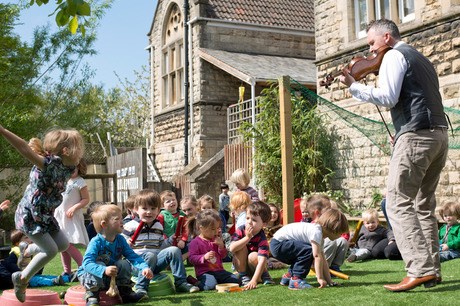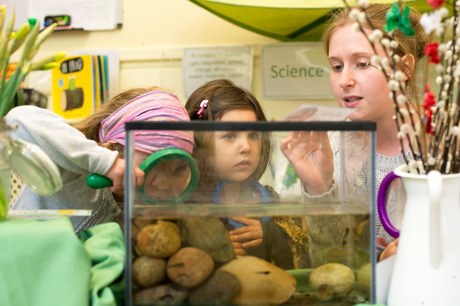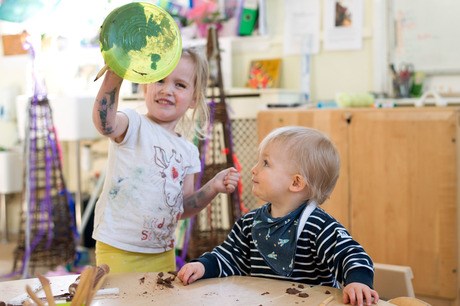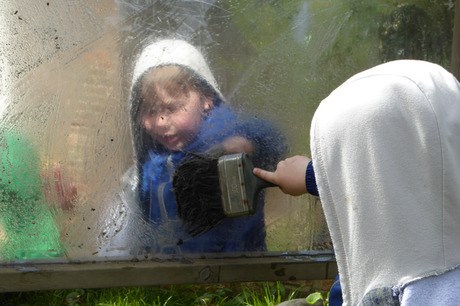Nursery Equipment: Planning - Be inspired
Nicole Weinstein
Wednesday, May 20, 2015
To create effective 'enabling environments', we must be open to ideas from a range of sources, including educational pioneers, overseas settings and children themselves, says Nicole Weinstein.

Many settings take the 'cookie cutter' approach to enabling environments, planning their nursery around a rough template of core areas and resources. But while the Early Years Foundation Stage (EYFS) framework states that settings should provide a 'challenging' and 'developmentally appropriate' environment 'based on children's interests', it does not stipulate how to lay out a nursery. And Ofsted's prime concern is not about how settings approach their learning environment: it is about meeting the outcomes. So, where can settings turn to for inspiration to think more deeply and creatively about their enabling environments?
Most nurseries will typically have five or six activity areas, but practitioners who are tuned into their children's needs and interests - and with their own creative passions - will often give prominence to a particular area.
Martin Huleatt of Community Playthings explains, 'When staff invest in some area they are personally inspired about, children's learning moves to new levels. I have seen nurseries with a special emphasis on art because staff had visited Reggio Emilia. It's beautiful to see how children thrive when staff take this flexible view of their space.'
There is plenty of scope for individuality when staff glean imaginative ideas from abroad, including Iceland (pages 16-18), from different philosophies, such as Montessori (pages 26-27) and from different approaches, such as that in Scotland with its emphasis on creativity (pages 12-13). Early years practice in Scandinavia is also encouraging settings to spend ever more time outdoors (pages 8-10).
Most importantly, settings should find inspiration by observing the children in their care. Helen Huleatt of Community Playthings says, 'I visited a nursery school in Wales that emphasised role play because the head believed children needed generous opportunity to play family. The children got deeply involved and communication exploded.' (See pages 20-21.)
However, responding to children's changing interests and keeping up with current trends in their lives must also be kept in mind when planning a learning environment. Access to laptops, iPads and other forms of digital technology are becoming more commonplace within nurseries across the UK as practitioners take steps to ensure that the real world that children live in is reflected in the nursery environment (pages 32-34).
TRIED AND TESTED
While a one-size-fits-all approach to planning an enabling environment is impossible, settings can turn to some longstanding tried-and-tested approaches that have been 'proven to work', says Beatrice Merrick, chief executive of Early Education.
'We know the value of malleable play for building strength in fingers and fine motor control and we know the value of the outdoors for all kinds of learning. The rationale behind the different resource areas of sand, clay, water and block play is set out in Core Experiences for the EYFS by Kate Greenaway Nursery School and Children's Centre,' she explains.
Nevertheless, planning still needs a lot of thought because, says Caroline Eaton, early years consultant and author of Enabling Environments on a Shoestring, the environment has the power to 'close learning down or to open it up'. Take, for example, the water-play area. 'If you have three buckets that are the same size and made of the same material, you miss out on the opportunity for a child to say, "I'd like to use the large shiny bucket with the green handle". The more open-ended the resources, the more opportunities children have to go back to explore,' she explains.
'It is also important for practitioners to think about the skills and concepts that can be gained or the muscle groups used. In a construction area, for instance, it might look like you are offering a lot of choice if you have Duplo, Lego and Mobilo, but all of these resources are joined in the same way: by pushing them together. Whereas if you have Brio, blocks and Mobilo, you are offering a wider range of skills to refine.'
It is important, too, to create well-defined and attractive play spaces to draw children in and avoid distractions once they are engaged (pages 30-31).
CASE STUDIES
Atelier Nursery in Bath and Quackers playgroup in York have found inspiration from abroad and made great strides in putting children's interests at the heart of learning environments.
Atelier Nursery, Bath

The Piazza at Atelier Nursery is alive with activity. In this area - a central meeting point inspired by Reggio Emilia - architects don hard hats and flit from their 'office', in the loft, to the 'construction site' stocked with hundreds of blocks.
There are spirit levels, architects' plans, clipboards, pens and papers. Children are discussing where to place blocks or clear spaces for the next delivery of bricks. Some are fine-tuning their building plans at the office desk while others are documenting their work and taking pictures of their constructions on iPads.All this activity follows on from the nursery's work about the local community, explains co-owner Clare Crowther, as she takes me on a virtual tour of the setting on Skype.
'After looking at the local architecture, we were invited to observe the renovation work being undertaken at a child's home,' she says. 'The architect came into the nursery to show the plans and explain his part in the process and we added the relevant resources in each of the learning zones to extend the learning and carry on the theme.'
Wherever possible, the 61-place setting uses the wider community to enhance children's experiences and understanding, to embed prior learning or provoke new thinking. The children have been on an open-top bus tour to view the city's architecture, celebrated Chinese New Year at a local Chinese restaurant, and go on weekly trips to museums and galleries.
'For us, the term "enabling environment" has to be set in a wider context of what we're doing,' says Ms Crowther. 'The environment is the third teacher. It has to be aesthetically pleasing, it has to be clutter free and it has to be full of provocations so that the children can revisit, extend and develop their work.
'Taking inspiration from New Zealand, we work closely with our community to give children a sense of belonging. Our babies sleep outside in the garden and the outdoors is accessible all day. There's a stage for creative work, a story hut, climbing spaces that enable children to take risks, and real tools and woodwork benches.'
The layout consists of five indoor and two outdoor learning spaces:
The Nest - a safe, spacious area for non-mobile babies, allowing them to practise their motor skills while remaining contained for their protection. Resources include treasure baskets, heuristic play, lights and mirrors, and babies are offered a sensory experience enhanced by baby massage and baby yoga. The sleep room, linked to this area, is a quiet space where children can curl up in one of the specially designed nests or their own coracle.
The Piazza - here, children's pictures and projects decorate the walls and learning is shared through photographs and videos to promote discussion and debate. Laptops and iPads allow children to capture their work and extend their learning as they research the world around them. Also available are maple blocks that enable the children to design, represent, recreate and construct, developing fundamental skills for future learning such as involvement, motivation, and perseverance. The Piazza also promotes communication and language. Smaller hidden spaces provide the perfect den for emergent writers and future architects to work from as they plan their constructions.
The Discovery Room - here, children can explore, investigate, make discoveries about the world around them and reflect on how things work and why things happen. A large beach allows them to pour, fill, mix, contain, and transport as they work things out. There is also a huge focus on open-ended resources, natural materials and the use of loose parts, where the children can explore trunks and bark or take apart old machines. They can also be found feeding the land snails, caring for the guinea pigs, and planting and observing growth.

The Snug - this has resources such as clays and dough, sand and water, mirrors and lights, and is primarily for younger children, although all ages can access any area they want.
The Studio - in this area, children experiment with everything from paint and collage to natural and recycled materials, and work with the resident artists across many forms and media.

Ms Crowther says, 'We've worked very hard to ensure that there's free flow and free movement within all the spaces. There are low-level walls and windows that connect the areas and encourage children to circulate throughout the spaces.
'There are gentle zones so that children have private spaces to concentrate on their work because there are such diverse age ranges entering the spaces. We have a workshop approach where children are encouraged to collect their own resources, put them back and take care of them.
'Our approach works on the recognition that children, just like adults, learn best when they are able to explore their interests fully and follow their own agendas through play for any given length of time. There is a seamless flow of learning opportunities presented to children, as staff enhance the basic provision to inspire and engage the children's individual interests. This allows children to revisit, extend or adapt their interests and learning as they wish, thus ensuring a deep level of engagement and high levels of progress.'
The underpinning principles of the nursery philosophy are influenced by nationally and internationally recognised best practice, including Reggio.
Ms Crowther explains, 'We have taken the elements that we believe work best for children and families from across the world and rolled them into one special place. Our pedagogy has been heavily influenced by early years educators and pioneers. Margy Whalley describes this practice as "standing on the shoulders of giants", and we like this expression.'
Quackers, York

Quackers is a private, 23-place setting based in a converted bungalow on a school site in the village of Copmanthorpe, on the outskirts of York. The setting has one large, open-plan, L-shaped room and an enclosed garden. In the past ten years, it has changed from a pack-away nursery to one with its own premises. Careful thought has gone into the resources, storage and how to encourage free flow from one activity to another.
Owner Menna Godfrey says, 'Over the years, our spaces have changed to reflect children's needs. For example, I recently reorganised our storage after observing that children were playing in front of the cupboards and becoming frustrated when another child walked through their play to access the resources. I've moved the cupboards away from some of the walls so that children's play can go all the way up to the wall, uninterrupted. As a result, children are doing more complex buildings and there are more sustained levels of involvement.'
Another change that came about after a visit to early years settings in Iceland, was to section off an area of the setting using furniture and dedicate it to construction.
Mrs Godfrey says, 'This area contains mathematically determined Unit Blocks from Community Playthings, Duplo, sensory wooden blocks with coloured liquid inside and wooden small-world figures. Children have high levels of engagement as they build castles or dens and use the generic figures to represent people or animals in their play. Also, as they handle and construct with the Unit blocks, they are physically engaging with mathematical concepts.'
When Mrs Godfrey and her then business partners first set up the playgroup in 2005, she says the local authority guided them towards thematic planning that was determined by adults. 'This didn't sit comfortably with me,' she says. 'So, when the EYFS came out, combined with the knowledge I'd gained from my visit to settings in Denmark, where children were given more freedom to simply just "be" and to explore their own interests with open-ended resources, we had the confidence to take a fresh look at the space, redesign it with the children's interests in mind and present this to the local authority.
'We haven't looked back. We now have an exploratory area with a sink, paint, fabric, pens and crayons that children can access independently. Here, when they're learning to cut, glue, or represent their ideas, they have the freedom to choose resources. We also have story space that includes a sofa with lots of cushions and blankets, open-ended dressing-up clothes and resources for role play.
'We originally had lots of different areas that were sectioned off with boundaries and too many resources. Minimising the boundaries has freed up the space and it's had a positive effect on the children. What makes it all worthwhile is when you see - and when outsiders comment on - the children's levels of involvement in their play, and that means that deep-level learning is taking place.'
MORE INFORMATION
Core Experiences for the EYFS by Kate Greenaway Nursery School and Children's Centre, Early Education (www.early-education.org.uk)
Enabling Environments on a Shoestring: a guide to developing and reviewing early years provision by Caroline Eaton, Early Education.




